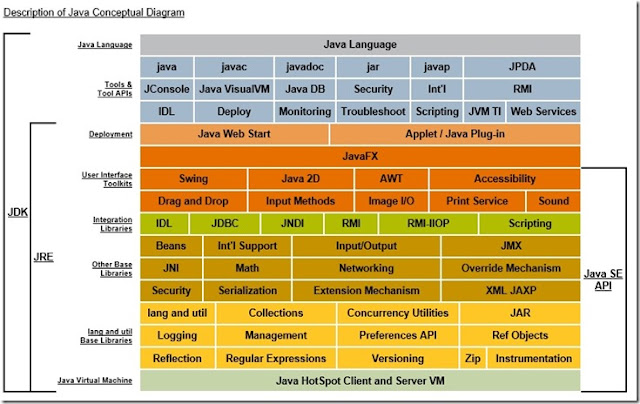Let’s assume JDK is installed at \jdk1.7.0, below are some of the most important directories and their explanation
jdk1.7.0
db
include
src.zip
bin
java*
javac*
javap*
javah*
javadoc*
lib
tools.jar
dt.jar
jre
bin
java*
lib
applet
ext
jfxrt.jar
localdata.jar
fonts
security
sparc
server
client
rt.jar
Charsets.jar
db
include
src.zip
bin
java*
javac*
javap*
javah*
javadoc*
lib
tools.jar
dt.jar
jre
bin
java*
lib
applet
ext
jfxrt.jar
localdata.jar
fonts
security
sparc
server
client
rt.jar
Charsets.jar
\jdk1.7.0 → This is the root directory of the JDK software installation which contains copyright, license, and readme files, src.zip and all other directories.
\jdk1.7.0\bin → Contains files for all executable tools which are necessary for Java program development . The PATH environment variable should contain an entry for this directory. Some of them are
- appletviewer: Run and debug applets without a web browser.
- extcheck: Utility to detect Jar conflicts.
- jar: Create and manage Java Archive (JAR) files.
- java: The launcher for Java applications.
- javac: The compiler for the Java programming language.
- javadoc: API documentation generator.
- javah: C header and stub generator. Used to write native methods.
- javap: Class file disassembler
- jdb: The Java Debugger.
\jdk1.7.0\lib → Files used by the development tools, includes the following:
- tools.jar: Contains non-core classes for support of the tools and utilities in the JDK.
- dt.jar: DesignTime archive of BeanInfo files that tell interactive development environments (IDEs) how to display the Java components and how to let the developer customize them for an application.
- ant-javafx.jar: Contains Ant tasks for packaging JavaFX applications; see Packaging in Deploying JavaFX Applications.
Other jars are jconsole.jar, packager.jar, sa-jdi.jar.
\jdk1.7.0\jre → Root directory of the Java runtime environment used by the JDK development tools. The runtime environment is an implementation of the Java platform. This is the directory represented by the java.home system property.
\jdk1.7.0\jre\bin → Contains executable files and DLLs for tools and libraries used by the Java platform. The executable files are identical to files in /jdk1.7.0/bin. The java launcher tool serves as an application launcher (and replaced the old jre tool that shipped with 1.1 versions of the JDK). This directory does not need to be in the PATH environment variable.
\jdk1.7.0\jre\bin\client → Contains the DLL files used by the Java HotSpot™ Client Virtual Machine.
\jdk1.7.0\jre\bin\server → Contains the DLL files used by the Java HotSpot™ Server Virtual Machine.
\jdk1.7.0\jre\lib → Code libraries, property settings, and resource files used by the Java runtime environment. For example:
- rt.jar: Contains all Java platform's core API classes. These classes are loaded by Bootstrap Classloader.
- charsets.jar: Character conversion classes
- jfxrt.jar: JavaFX runtime libraries
Aside from the ext subdirectory (described below), there are several additional resource subdirectories not described here.
\jdk1.7.0\jre\lib\ext → Default installation directory for Extensions to the Java platform, Loaded by extension classloader.
- localedata.jar: locale data for java.text and java.util.
\jdk1.7.0\jre\lib\security → Contains files used for security management. These include the security policy (java.policy) and security properties (java.security) files.
\jdk1.7.0\jre\lib\applet → Jar files containing support classes for applets can be placed in the lib/applet/ directory. This reduces startup time for large applets by allowing applet classes to be pre-loaded from the local file system by the applet class loader, providing the same protections as if they had been downloaded over the net.
\jdk1.7.0\jre\lib\fonts → Contains TrueType font files for use by the platform.
There are some additional files and directories which are not required to a Java developer like below
\jdk1.7.0\src.zip → Archive containing source code for the Java platform.
\jdk1.7.0\include → C language header files that support native-code programming using the Java Native Interface and the Java Virtual Machine Debugger Interface.
Reference: Java Documentation













